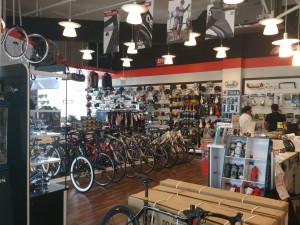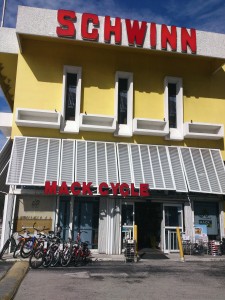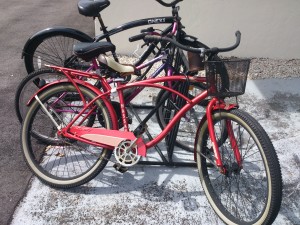Posted Oct. 4, 2013
By PATRICK RILEY
If you have ever had the pleasure of visiting Amsterdam, you will have noticed that the Dutch metropolis is not only famous for its raunchy red light district and its equally free-spirited drug laws, but also for something far more mundane.
Bicycles.

The EBP Cycling Lab in Coral Gables does group rides on Tuesdays, Thursdays and Saturdays (Photo by Patrick Riley).
Everybody, and I mean everybody, rides a bike in Amsterdam. It is the mode of transportation of choice for Dutchmen and women and this two-wheeled enthusiasm has made Amsterdam the bicycle capital of the world. According to the travel website Virgin Vacations, a whopping 40 percent of all traffic movements in Amsterdam happen by bike.
That being said, if Amsterdam is a bicyclist’s Mecca, then Miami is a Sodom and Gomorrah.
“It’s dangerous,” said Frank Masiero, manager of EBP Cycling Lab in Coral Gables. “There are people like they’re in a rush, there are people, you know, they want to get the kids to school fast, they’re angry, they’re cranky.”
Masiero is, of course, referring to South Floridian drivers and their often-times erratic tempers. Masiero, an avid bike rider himself – he rides his bike to Key Biscayne every day – has had plenty of near-accidents. Sometimes even with the ones who should be serving and protecting him.
“One really close one with the law, with a police car,” said Masiero when asked whether he has had any close calls while riding a bike in Miami. “He almost ran me over, he didn’t care. I couldn’t complain, because there’s nothing to complain about, I couldn’t do anything.”
Far more hazardous to cyclists’ health, though, are drivers who talk on the phone or text while behind the wheel.
“This one lady, one time, I was driving and she basically touched me with the side mirror and then when I saw here she was talking on the phone,” Masiero said.
Unfortunately, the numbers resonate with Masiero’s experiences. According to the Florida Department of Highway Safety and Motor Vehicles’ website, 6,058 bikers were injured in accidents in 2012, a 31 percent increase from the year before. The number of bicycle riders who were killed did go down, but only marginally, from 120 in 2011 to 116 in 2012.

Mack Cycle & Fitness on Sunset Drive in Miami has everything a cyclist’s heart can possibly desire (Photo by Patrick Riley).
Masiero said that it often depends on the time of day (“The morning usually is the best time for riding.”) and the area (“Key Biscayne is the safest area to ride.”), but that in general he doesn’t think Miami is very bike-friendly.
Fortunately, not all hope is lost. Just ask Sue Kawalerski, cycling advocate and special events coordinator for Mack Cycle, a Coral Gables bike store.
“Miami continues to improve to become a bike-friendly city,” Kawalerski said. “In fact, the League of American bicyclists awarded the City of Miami a designation that it is a bike-friendly city a year ago. And I think the city of Miami, in particular, continues to make some nice improvements for cyclists, particularly in the area of putting very large “sharrows” on roads designating those roads to be used by not only vehicles but by non-motorized vehicles like bicycles. So I think it’s trying to make the motorists aware that there needs to be a sharing of the road. […] I think they’re also trying to continually find money to build in bike lanes and improve existing bike lanes. So, it is on its way to becoming what we would consider truly a bike-friendly city.”
But even with those steady improvements, nationally, Miami still lags behind when it comes to creating a safe and enjoyable biking experience.
“There [are] some very progressive cities in this country that have made cycling and alternative transportation a priority, like Portland, Ore., many cities within the state of Washington, like Seattle,” Kawalerski explained. “The Pacific Northwest communities in the United States are very, very advanced in this area. Parts of California are becoming pretty advanced in making sure that cyclists have safe venues. New York City, believe it or not, is very progressive. Actually on the island of Manhattan they have become very progressive in making it safer for cyclists. I think Miami is on its way, it’s headed in the right direction, but it’s certainly not as progressive as some of those cities I mentioned.”
For Kawalerski, local organizations and clubs like the Everglades Bicycle Club, where she is a certified ride leader, and various triathlon clubs as well as Mack Cycle play a big role in making elected officials aware of the need for more safe venues for bikers.
But there are also steps bikers themselves can take to make their riding experience safe and fun.

Experts agree that if biking is to become safer in Miami, a joint effort has to be made by cyclists, drivers and local authorities, alike (Photo by Patrick Riley).
“There are a number of tools available now for cyclists that point them in a good direction where it is safe to cycle,” Kawalerski said. “One of those tools can be found on www.bike305.com, which is a Miami-Dade County effort to direct people to paved paths, versus roads, that are pretty continuous and fairly safe to ride on versus the streets.
“FIU has developed a phenomenal tool for cyclists to use that basically shows where the safe roads are, where the least trafficked roads are. So FIU has developed and continues to develop this great mapping tool for cyclists to use and we here at Mack Cycles suggest to folks new to bikes where they can ride safely. Everglades Bicycle Club has weekly rides on Saturday mornings for groups and it also teaches safe cycling skills. So not only do you get a nice lesson on how to ride in a group, but you get a nice ride out of it too.”
Masiero agrees that safe biking has to be a joint effort.
“Everybody has to cooperate,” Masiero said. “I mean even cyclists who have been in groups that they take the whole street – that shouldn’t be. […] Cyclists they have to do their part, like if they’re alone they have to be closest to the [side] of the road. […]So it’s cooperation between cyclists and cars.”
He also knows that if bicyclists and drivers can come together, it will be worthwhile.
“It’s a nice sport,” Masiero said. “It’s something that doesn’t harm your body at all. You have fun and that’s it.”
If You Go
- Everglades Bicycle Club Inc.
P.O. Box 430282
South Miami, Fla., 33243
305-389-0221
http://www.evergladesbc.com/
- Mack Cycle & Fitness
5995 Sunset Dr.
Miami, Fla., 33143
305-661-8363
800-641-8363
Mondays-Fridays: 10 a.m. to 7 p.m.
Saturdays: 9 a.m. to 6 p.m.
Sundays: Noon to 5 p.m.
info@mackcycleandfitness.com
- EBP Cycling Lab
1430 S. Dixie Highway, Suite 103
Coral Gables, Fla., 33146
786-453-3315
Mondays-Fridays: 10 a.m. to 7 p.m.
Saturdays: 9 a.m. to 6 p.m.
Sundays: out racing
http://www.ebpcyclinglab.com/
- Bike Broward – Interactive Bicycle Trip Planning
http://bikebroward.fiu.edu/mpobike/ - Bike 305
http://www.miamidade.gov/bike305/
